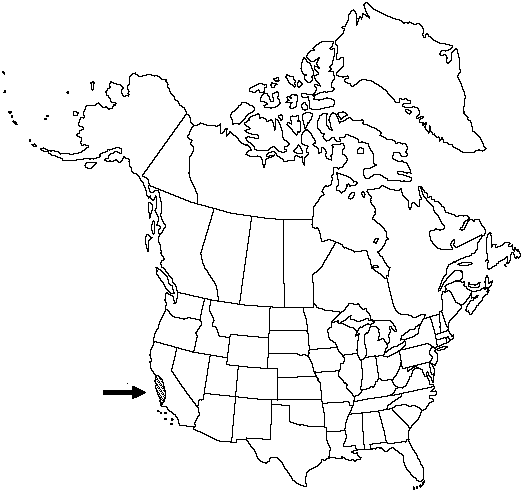Pinus radiata
Trans. Linn. Soc. London, Bot. 17: 442. 1836.
Trees to 30m; trunk to 0.9m diam., contorted to straight; crown broadly conic, becoming rounded to flattened. Bark gray, deeply V-furrowed, furrow bases red, ridges irregularly elongate-rectangular, their flattened surfaces scaly. Branches level to downcurved or ascending, poorly self-pruning; twigs slender, redbrown, sometimes glaucous, aging gray, rough. Buds ovoid to ovoid-cylindric, redbrown, ca. 1.5cm, resinous. Leaves (2–) 3 in a fascicle, spreading-ascending, persisting 3–4 years, (8–) 9–15 (–20) cm × 1.3–1.8 (–2) mm, straight, slightly twisted, deep yellow-green, all surfaces with fine stomatal lines, margins serrulate, apex conic-subulate; sheath (1–) 1.5–2cm, base persistent. Pollen cones ellipsoid-cylindric, 10–15mm, orangebrown. Seed-cones maturing in 2 years, shedding seeds soon thereafter, but often serotinous and persistent 6–20 years, solitary to whorled, spreading to recurved, curved, very asymmetric, ovoid before opening, broadly ovoid when open, 7–14cm, pale redbrown and lustrous, scales rigid, stalks to 1cm; apophyses toward outer cone base increasingly mammillate, those on inward cone side and middle and apex of cone more level; umbo central, mostly depressed, with small central boss or occasionally with slender, deciduous prickle. Seeds compressed-ellipsoid; body ca. 6mm, dark-brown; wing 20–30mm. 2n =24.
Habitat: Coastal fog belt
Elevation: 30–400m
Distribution

Calif., Mexico in Baja California [600–1200 m]
Discussion
Pinus radiata has an extremely narrow natural range: three coastal areas in California (one in San Mateo and Santa Cruz counties, one in Monterey County, and one in San Luis Obispo County) and off the coast of Baja California, Mexico (Guadalupe Island and debatably also on Cedros Island). Some natural populations of the species are under protection. Along the California coast it has escaped from cultivation, and from there into southern coastal Oregon it shows signs of naturalizing.
Pinus radiata is a much better-formed tree and of greater silvicultural value within its introduced range (Africa, Australia, Europe, and New Zealand, where it is a principal timber tree) than in its native range. It hybridizes naturally with P. attenuata (P. × attenuiradiata Stockwell & Righter).
Of conservation concern.
Selected References
None.
Lower Taxa
"relatively thin" is not a number.